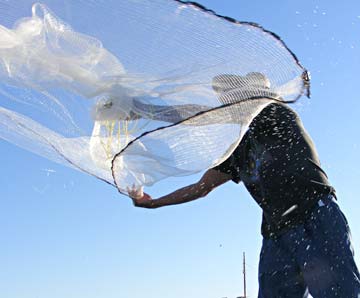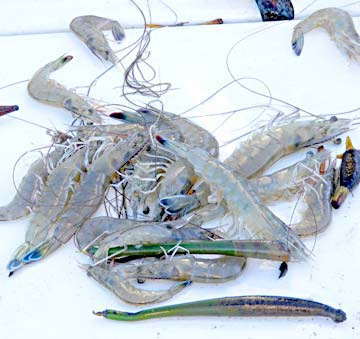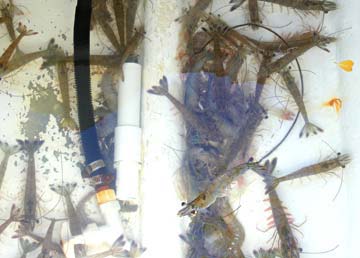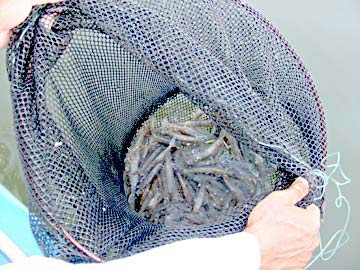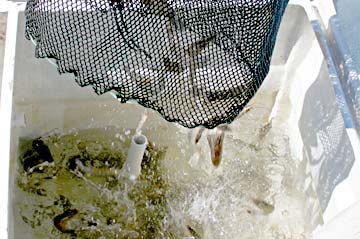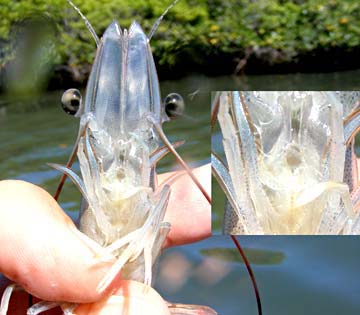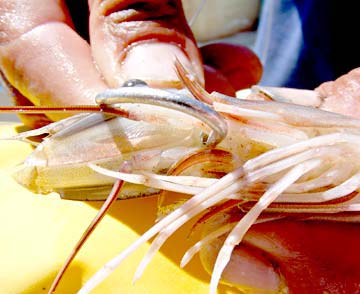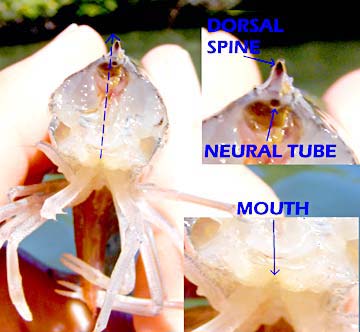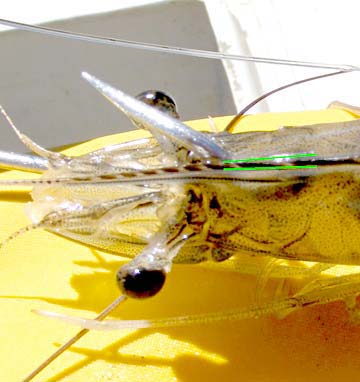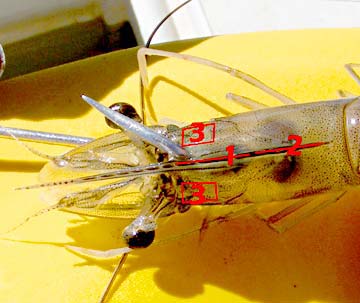
Magdalena Bay, Mexico
![]()
COLLECTING AND USING LIVE SHRIMP BAITS AT MAGDALENA BAY
November 5, 2007, Jeff Petersen, Lopez Sportman's Lodge, Puerto Lopez Mateos, Baja California Sur, Mexico:
Shrimp are legal to catch at Lopez Mateos only in October, November, December, and January by licensed Mexican commercial fishermen.
|
|
Of the many places shrimp might live, they really like Magdalena Bay. In higher water, they flourish within the mangroves. In lower water, they scurry to the channel bottoms. Bahia Magdalena is a shrimp habitat. As part of this paradise, fish eat them. They prefer to eat shrimp. Unlike man, however, fish won't eat dead shrimp.
In the mangroves, at least 11 categories of game fish of interest might be caught with shrimp bait. The Spanish names of these fish are: robalo, garropa, pargo rojo, pargo colmilludo, pargo coconaco, corvina, paleta, bacoco, vieja, cochi, lenguado, curricata, and pampano.
There are 2 colors of shrimp found in the Magdalena Bay mangroves, blue and brown, or azul y café in Spanish. Blue shrimp are caught in the daytime. Brown shrimp at night. For bait, the color is not important. Medium size is best.
A Mexican casting net, called atarraya in Spanish, is used by commercially licensed fishermen to catch shrimp. A fisherman seeking shrimp will find them in canal bottoms day or night if the water is low.
Low tide is the most productive period for the collection of shrimp at Magdalena Bay by cast net or atarraya. Assorted sea life is separated from the shrimp and they are put into the bait tank, ready for use on the fishing grounds, or they are kept in the water for live bait storage. When kept in the water the shrimp container attachment cord should be tied off high and visible for easy recovery at high water.
Liveliness and unimpaired movement must be maintained for the effective use of shrimp bait. Additionally, the shrimp form must plane through a current without tangling and impairment to the line. Hence, the following hooking method is presented for live shrimp, effectively serving these goals.
For proper hooking to keep the shrimp bait alive, the hook entry is upwards through the mouth of the shrimp. Many structures around the mouth of a shrimp are designed to push food into their complicated mouths. Push back what's necessary to visualize the spot. The hook exit is just next to the dorsal spine, missing the small neural tube. The hook must not puncture the neural tube or the shrimp will go limp. If the hook punctures the cerebral area the shrimp will die. If the hook is too far off center, however, the shrimp will windmill in the water and twist the line.
Few pangueros know the care and feeding of shrimp baits. About 150 baits should hold 2 anglers for a day of fishing. They'll feed a lot of fish and you may also have shrimp left for dinner.
The amount of sea life that comes up in the net along with the shrimp can be unimaginable. Rather than shuffling the whole of it into the bait tank, the extras, from fish of many sizes, to shellfish, crabs, critters, squid, and mangrove parts, are returned to the sea, and only the shrimp and clean water are put in the bait tank.
You will go through the trials of grabbing a shrimp and baiting it. When our Captain Chico and his son fish together, like baseball players, one scoops a shrimp up from the bait tank like a shortstop, pitching it to the other's hat at the other end of the boat.
The big fish that seek these shrimp, as a child seeks candy, test the steadfastness of an artificial lure angler. Fishing in the mangroves at 30 feet, possible even in swift current, or at 72 to 138 feet on the Pacific for grouper or whatever, one has good sensitivity with this bait.
Tourists will need a licensed commercial Mexican panguero for the legal collection of shrimp bait. Shrimp are not legal to catch with a sportfishing license. The commercial shrimp season at Magdalena Bay is October through January.
|
Low tide is the most productive period for the collection of shrimp. Chico casts his net. |
|
From the net to the deck. Assorted sea life is separated. |
|
In the bait tank, ready for fishing or live storage. |
|
About 150 baits for 2 fishermen, these shrimp are confined for live storage. |
|
Live storage deposit. The attachment cord should be tied off high and visible for easy recovery at higher water. |
|
Baits are returned to the boat on the day of fishing. |
|
Mouth of a shrimp. This is the point of introduction of the hook. |
|
Hook entry is through the mouth. |
|
Hook exit is just lateral to the dorsal spine, missing the neural tube. |
|
Entry at the mouth, exit lateral to the dorsal spine, missing the neural tube. |
|
Exit limits of the hook along lateral border of the dorsal spine. Green limit is represented. |
|
Hook must not exit in red zones: mid-line or neural tube puncture (limp shrimp); cerebral area (dead shrimp); exit area beyond close proximity to the dorsal spine (induced lateral rotation). PHOTOS BY JEFF PETERSEN, LOPEZ SPORTSMAN'S LODGE, MAGDALENA BAY, BAJA CALIFORNIA SUR, MEXICO. |
MEXICO FISHING HOME PAGE MAGDALENA BAY FISHING "MEXICO FISHING NEWS" FISH PHOTO GALLERY
